During the weekend of October 11-12th, 2014, members of the ISC’s KHEP (Korean History, Economics, and History Program) team traveled to Sangju in Gyeongsangbukdo for a weekend of volunteer farming work with 승곡농촌체험마을 (the Seunggok Farming Experience Village), an organic farming village. Throughout the weekend, members harvested pears, red peppers, perilla, and buckwheat, as well as conversed with members of the Korean Peasants League and the Korean Women Peasants Association. Below are their reflections on the weekend experience:
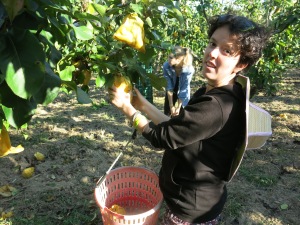 Although I had already experienced urban and rural farming in Korea, I really enjoyed our visit to the “Back to the Land” village in Sangju. Though a staunchly conservative region of the country, the Peasants League and Korean Women’s Peasant Association are active here and they were very open to sharing their struggles with the ISC team. We also did truly meaningful physical work – picking the well-known Sangju pears and threshing perilla and buckwheat, all while munching on persimmon and enjoying our lovely surroundings. We struck a good balance between work and in-depth conversation, especially as we shared our personal connections to food and farming over a round of drinks with the farmers. A great learning weekend. – Ana Traynin
Although I had already experienced urban and rural farming in Korea, I really enjoyed our visit to the “Back to the Land” village in Sangju. Though a staunchly conservative region of the country, the Peasants League and Korean Women’s Peasant Association are active here and they were very open to sharing their struggles with the ISC team. We also did truly meaningful physical work – picking the well-known Sangju pears and threshing perilla and buckwheat, all while munching on persimmon and enjoying our lovely surroundings. We struck a good balance between work and in-depth conversation, especially as we shared our personal connections to food and farming over a round of drinks with the farmers. A great learning weekend. – Ana Traynin
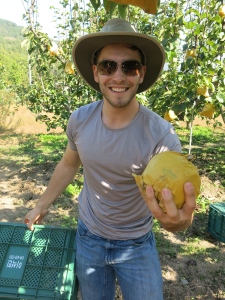 I was invited to partake in some of the autumn 2014 harvesting activities at the Saebyeok Farm. I looked forward to a weekend away from the city surrounded by nature and some good healthy labor as a switch-up from lab work. Upon arrival, we were given a hearty welcome by Jo Won-Hee, an avid farmer and member of the Korean Peasants League. We immediately jumped into the works going on by gathering dozens of crates full of pears along with Lee Seok-Min, another farmer of the cooperative. We learned some of the science and methodology of family-style farming, along with some of the social issues facing small farmers in light of free trade. Additionally, we were exposed to the implications of insurgence of imported food to South Korea. We also met with the president of the Korean Peasant’s Woman Association to hear of some of the struggles for female farmers in Korea. Coming from a place where you really should wash everything before eating, it was almost like a Willy Wonka experience to be able to just pick a huge pear off of a tree and taste some of the freshest fruit ever experienced. It did not end there; we also sampled a fair share of persimmon. The next day we continued to harvest various peppers and buckwheat before making the trek back to Seoul. Throughout the weekend, we met some very kind people who made sure we felt as welcome as possible. My first farming experience was well had. – Matt D’Arcy
I was invited to partake in some of the autumn 2014 harvesting activities at the Saebyeok Farm. I looked forward to a weekend away from the city surrounded by nature and some good healthy labor as a switch-up from lab work. Upon arrival, we were given a hearty welcome by Jo Won-Hee, an avid farmer and member of the Korean Peasants League. We immediately jumped into the works going on by gathering dozens of crates full of pears along with Lee Seok-Min, another farmer of the cooperative. We learned some of the science and methodology of family-style farming, along with some of the social issues facing small farmers in light of free trade. Additionally, we were exposed to the implications of insurgence of imported food to South Korea. We also met with the president of the Korean Peasant’s Woman Association to hear of some of the struggles for female farmers in Korea. Coming from a place where you really should wash everything before eating, it was almost like a Willy Wonka experience to be able to just pick a huge pear off of a tree and taste some of the freshest fruit ever experienced. It did not end there; we also sampled a fair share of persimmon. The next day we continued to harvest various peppers and buckwheat before making the trek back to Seoul. Throughout the weekend, we met some very kind people who made sure we felt as welcome as possible. My first farming experience was well had. – Matt D’Arcy
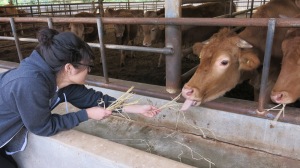 As someone who grew up not only in produce-rich California but a town known for agriculture, yet had never experienced farming, I arrived for the weekend excited yet not quite sure what to expect. Thanks to the kindness and consideration of our host Jo Won-Hee, his family, and the rest of the Seunggok Village community, my first experience with farming was both fun and fulfilling. There’s something deeply satisfying about being able to see the fruits of your labor (pun intended). It also wasn’t until leaving Seoul that I realized how much of a tangible effect urban living has; in the countryside the air felt cleaner, the food tasted better, and people seemed more at peace, making the return to the hustle and bustle of Seoul a jarring one.
As someone who grew up not only in produce-rich California but a town known for agriculture, yet had never experienced farming, I arrived for the weekend excited yet not quite sure what to expect. Thanks to the kindness and consideration of our host Jo Won-Hee, his family, and the rest of the Seunggok Village community, my first experience with farming was both fun and fulfilling. There’s something deeply satisfying about being able to see the fruits of your labor (pun intended). It also wasn’t until leaving Seoul that I realized how much of a tangible effect urban living has; in the countryside the air felt cleaner, the food tasted better, and people seemed more at peace, making the return to the hustle and bustle of Seoul a jarring one.
At the same time, though, I felt very conscious of the fact that, while this was merely a fun educational weekend activity for us, for the farmers we worked with, this was their life’s work and livelihood. They spoke candidly about the negative impact the FTA and other neoliberal policies have had on them and how protesting them is essential not only to protecting their way of life but for food sovereignty of Korea. As anxious as I feel right now about earning a sufficient income on a month-to-month basis, I can hardly imagine staking a year’s work and income on crops; and after seeing the dedication and care that goes into family farming, ensuring their security seems like something that should be a given. Yet, despite these hardships, the image that has remained with me is not one of victimhood, but of inspiring protagonism, of people who prize their right to self-sufficiency and a relationship with the land despite the forces of capitalism and neoliberalism. – Stephanie Park
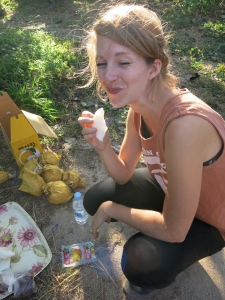 Having just arrived in Korea a little over a month ago, I’ve been immensely curious about life outside of Seoul, in particular rural and agrarian life. Both Koreans and foreigners had told me there isn’t much to see in the Korean countryside. They dismissed its importance, remarking how there is very little un-urbanized land and what remains isn’t picturesque or well groomed. However, after a short but transformative weekend in Sangju, it became clear that the rural landscape and the communities that reside there are an indispensible part of South Korea’s past, present and future.
Having just arrived in Korea a little over a month ago, I’ve been immensely curious about life outside of Seoul, in particular rural and agrarian life. Both Koreans and foreigners had told me there isn’t much to see in the Korean countryside. They dismissed its importance, remarking how there is very little un-urbanized land and what remains isn’t picturesque or well groomed. However, after a short but transformative weekend in Sangju, it became clear that the rural landscape and the communities that reside there are an indispensible part of South Korea’s past, present and future.
In the village, the air was fresh and rejuvenating; the fresh fruit and vegetables were nourishing, and the people were charming and welcoming. But there was more to our experience than these pleasant breaks from dense city-life. The long and intimate conversations with farmers revealed struggle, vulnerability, and defeat alongside courage, activism and empowerment. At times, I felt hopeless for this group as they spoke of their struggles with the free trade agreements and massive GMO seed companies. And yet, much of the time I felt huge waves of empowerment overtake these thoughts when they would speak about KWPA, Sister’s Garden Plot, or the back to the land movement. I left Sangju feeling the importance of this under-appreciated group of people and their landscape. In this place, a rare continuity of time still exists. Layers of Korean history still occupy the rural landscape and the memories of those living there – whether it’s the political history still restraining them, or the ancient traditions of community and ancestor worship still being practiced or remembered. And while the farmers keep a very present mindset structured by the weather and seasons, they are continually building, fighting, and working for the future of small-scale farming in South Korea.
It is clear that there is much to be learned from this group, about Korean history, food sovereignty, activism and more. While I learned an immense amount about Korean history, political structure and social movements, my personal role in the scheme of things also became clearer. I realize that we all have a say in these issues in some way and our decisions, actions and votes at home or in Korea, may ultimately impact the people we meet in a tiny farming village in South Korea. – Lindsay Burnette
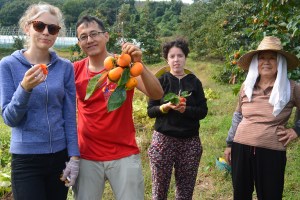 This past weekend the ISC traveled to Sangju, a ‘slow’ city in South Korea’s countryside to learn about farming. From the moment we stepped on to the farm we were welcomed with hospitality, smiles and fresh, delicious food. Each farmer we met was beaming as many told us of the move they had made from city life, to country living. We were given a taste of what food grown by a strong local community can look like. We spent the weekend discussing politics while picking pears, persimmons and peppers. Our work was rewarded with fruit juice, sweet potatoes and traditional home cooked meals. We saw how hard people work to grow and harvest food. It’s a simple, natural cycle that is often taken for granted. We live in a fast paced world where people hardly have time to chew, let alone cook. People are disconnected from their food, most never have a moment to slow down and appreciate where it comes from and how it’s grown. Food and farming have become increasingly complicated and political. Economic barriers and capitalism are destroying the balance humans have with nature. Instead of our food being directly in the hands of the people, it’s controlled by corporations. Over the course of the weekend, I came to the realization that this fight isn’t just about food- it’s much deeper. It’s about the different cultures and communities that surround the food. Local farming initiatives, like the one in Sangju, are not only growing food, they are helping to rebuild communities. They are dedicated to preserving a simple, healthy way of living. This weekend was literally and figuratively a breath of fresh air. I was fed some of the best food I’ve ever tasted, from some of the most hospitable people I’ve ever met. All the political and economic facts and figures from food related documentaries, articles and books I’ve been exposed to were given context. I am grateful to all the farmers who shared their stories, wisdom and their work with us. When it was time to go home I was refreshed and happy- I also felt a sense of urgency. Farms and communities like these are rare. If things don’t start to change soon they will no longer exist. Food is integral, not only to our survival, but to our happiness and quality of life. We need to slow down and reexamine our current relationship with food and help support local farmers who are taking the time to grow food we can feel good about eating. – Erica Sweett
This past weekend the ISC traveled to Sangju, a ‘slow’ city in South Korea’s countryside to learn about farming. From the moment we stepped on to the farm we were welcomed with hospitality, smiles and fresh, delicious food. Each farmer we met was beaming as many told us of the move they had made from city life, to country living. We were given a taste of what food grown by a strong local community can look like. We spent the weekend discussing politics while picking pears, persimmons and peppers. Our work was rewarded with fruit juice, sweet potatoes and traditional home cooked meals. We saw how hard people work to grow and harvest food. It’s a simple, natural cycle that is often taken for granted. We live in a fast paced world where people hardly have time to chew, let alone cook. People are disconnected from their food, most never have a moment to slow down and appreciate where it comes from and how it’s grown. Food and farming have become increasingly complicated and political. Economic barriers and capitalism are destroying the balance humans have with nature. Instead of our food being directly in the hands of the people, it’s controlled by corporations. Over the course of the weekend, I came to the realization that this fight isn’t just about food- it’s much deeper. It’s about the different cultures and communities that surround the food. Local farming initiatives, like the one in Sangju, are not only growing food, they are helping to rebuild communities. They are dedicated to preserving a simple, healthy way of living. This weekend was literally and figuratively a breath of fresh air. I was fed some of the best food I’ve ever tasted, from some of the most hospitable people I’ve ever met. All the political and economic facts and figures from food related documentaries, articles and books I’ve been exposed to were given context. I am grateful to all the farmers who shared their stories, wisdom and their work with us. When it was time to go home I was refreshed and happy- I also felt a sense of urgency. Farms and communities like these are rare. If things don’t start to change soon they will no longer exist. Food is integral, not only to our survival, but to our happiness and quality of life. We need to slow down and reexamine our current relationship with food and help support local farmers who are taking the time to grow food we can feel good about eating. – Erica Sweett